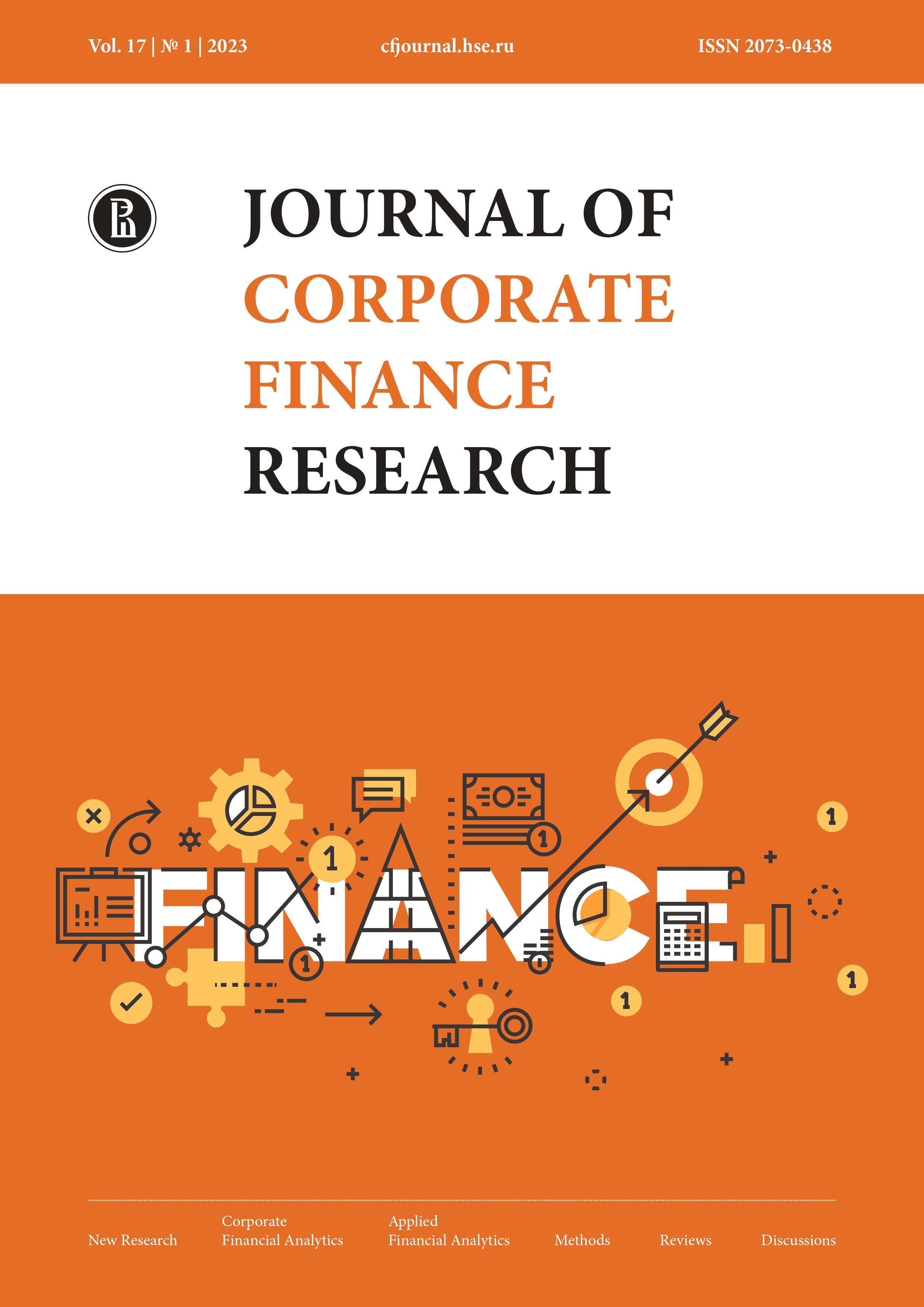Разработка скоринговой рейтинговой модели на основе методологии международных рейтинговых агентств
Аннотация
Целью настоящей статьи является изучение взаимосвязи между различными финансовыми и нефинансовыми (качественными) факторами эффективности нефинансовых компаний и их кредитными рейтингами. Мы разработали скоринговую рейтинговую модель нефинансовых компаний на основе методологий международных и российских рейтинговых агентств. Смоделированные рейтинги нефинансовых компаний за 2018–2020 гг. сравнивали с фактическими рейтингами, присвоенными рейтинговыми агентствами, и объясняли расхождения. В выборку входят компании из розничной торговли, сельскохозяйственной, сталелитейной и нефтегазовой отраслей России, США,
Люксембурга, Англии, Канады, Индии, Украины и Бразилии. Статья доказывает, что в результате добавления коммерческих и экологических, социальных факторов и факторов корпоративного управления качество скоринговых моделей повысилось по сравнению с моделями, включающими только финансовые метрики. В полученных рейтингах компаний в некоторых отраслях обнаружены сильные закономерности. Розничные компании ассоциируются с высокими показателями продаж, в то время как сталелитейные фирмы имеют высокие коэффициенты покрытия затрат на проценты. Нефтегазовые компании в основном демонстрируют высокие результаты по коэффициентам запасов.
В исследовании разработан инструмент прогнозирования кредитного рейтинга, имитирующий работу аналитиков рейтинговых агентств и, следовательно, обладающий высокой предсказательной силой. Разработанную модель могут использовать субъекты финансового рынка для прогнозирования кредитных рейтингов российских компаний в условиях, когда международные рейтинговые агентства отказываются присваивать рейтинги российским эмитентам.
Скачивания
Литература
. Zaidi D. The indisputable role of credit ratings agencies in the 2008 collapse, and why nothing has changed. Truthout. Mar. 19, 2016. URL: https://truthout.org/articles/the-indisputable-role-of-credit-ratings-agencies-in-the-2008-collapse-and-why-nothing-has-changed/ (accessed on 10.07.2021).
Glushenkova M. Intermediaries of ruin. Kommersant Den’gi. Jun. 01, 2009. URL: https://www.kommersant.ru/doc/1179079 (accessed on 12.11.2021). (In Russ.).
Factors behind the growing popularity of ESG investing. Nasdaq. Apr. 24, 2021. URL: https://www.nasdaq.com/articles/factors-behind-the-growing-popularity-of-esg-investing-2021-04-24
Bodnar G.M., Consolandi C., Gabbi G., Jaiswal‐Dale A. Risk management for Italian non‐financial firms: Currency and interest rate exposure. European Financial Management. 2013;19(5):887-910. https://doi.org/10.1111/j.1468-036X.2012.00659.x DOI: https://doi.org/10.1111/j.1468-036X.2012.00659.x
Lehmann B. Is it worth the while? The relevance of qualitative information in credit rating. SSRN Electronic Journal. 2003. https://doi.org/10.2139/ssrn.410186 DOI: https://doi.org/10.2139/ssrn.410186
Grunert J., Norden L., Weber M. The role of non-financial factors in internal credit ratings. Journal of Banking & Finance. 2005:29(2):509-531. https://doi.org/10.1016/j.jbankfin.2004.05.017 DOI: https://doi.org/10.1016/j.jbankfin.2004.05.017
Kiesel F., Lücke F. ESG in credit ratings and the impact on financial markets. Financial Markets, Institutions & Instruments. 2019;28(3):263-290. https://doi.org/10.1111/fmii.12114 DOI: https://doi.org/10.1111/fmii.12114
Zadorozhnaya T.M. The credit ratings of emitters defined by rating agencies. Rossiiskoe predprinimatel'stvo = Russian Journal of Entrepreneurship. 2012;(14):85-89. (In Russ.).
Singal M. Firm credit rating as a measure of organizational and financial performance. Journal of Business & Financial Affairs. 2013;2(3):1-2. https://doi.org/10.4172/2167-0234.1000e135 DOI: https://doi.org/10.4172/2167-0234.1000e135
Karminsky А.М. Corporate rating models for emerging markets. Korporativnye finansy = Journal of Corporate Finance Research. 2011;5(3):19-29. (In Russ.). https://doi.org/10.17323/j.jcfr.2073-0438.5.3.2011.19-29 DOI: https://doi.org/10.17323/j.jcfr.2073-0438.5.3.2011.19-29
Karminsky A.M. Credit ratings and their modeling. Moscow: LitRes; 2020. 305 p. (In Russ.).
Bergrem B.H. The determinants of creditworthiness: An empirical study of the relationship between credit ratings and financial ratios in the E&P industry. Master thesis in financial economics. Bergen: Norwegian School of Economics; 2014. 94 p. URL: https://openaccess.nhh.no/nhh-xmlui/bitstream/handle/11250/218454/Masterthesis.pdf?sequence=1&isAllowed=y
Rybalka А.I. Modeling the probability of default in the construction sector: Factors of corporate governance. Korporativnye finansy = Journal of Corporate Finance Research. 2017;11(3):79-99. (In Russ.). https://doi.org/10.17323/j.jcfr.2073-0438.11.3.2017.79-99 DOI: https://doi.org/10.17323/j.jcfr.2073-0438.11.3.2017.79-99
Karminsky A.M., Polozov A.A. Handbook of ratings: Approaches to ratings in the economy, sports, and society. Cham: Springer-Verlag; 2016. 356 p. https://doi.org/10.1007/978-3-319-39261-5 DOI: https://doi.org/10.1007/978-3-319-39261-5
Dyachkova N.F. The comparison of rating scales of Russian and foreign agencies: An empirical study for industrial and financial companies. Korporativnye finansy = Journal of Corporate Finance Research. 2018;12(2):153-170. (In Russ.). https://doi.org/10.17323/j.jcfr.2073-0438.12.2.2018.153-170 DOI: https://doi.org/10.17323/j.jcfr.2073-0438.12.2.2018.153-170
Curtis A.B., Lundholm R.J., McVay S.E. Forecasting sales: A model and some evidence from the retail industry. Contemporary Accounting Research. 2014;31(2):581-608. https://doi.org/10.1111/1911-3846.12040 DOI: https://doi.org/10.1111/1911-3846.12040
Banerjee A., De A. Determinants of corporate financial performance relating to capital structure decisions in Indian iron and steel industry: An empirical study. Paradigm: A Management Research Journal. 2014:18(1):35-50. https://doi.org/10.1177/0971890714540365
Retail industry methodology. Moody’s. 2018. URL: https://www.moodys.com/researchdocumentcontentpage.aspx?docid=PBC_1120379 (accessed on 10.07.2021).
Steel industry methodology. Moody’s. 2017. URL: https://www.moodys.com/researchdocumentcontentpage.aspx?docid=PBC_1074524 (accessed on 10.07.2021).
Protein and agriculture industry methodology. Moody’s. 2019. URL: https://www.moodys.com/researchdocumentcontentpage.aspx?docid=PBC_1113389 (accessed on 10.07.2021).
Oil and gas industry methodology. Moody’s. 2017. URL: https://www.moodys.com/researchdocumentcontentpage.aspx?docid=PBC_1056808 (accessed on 10.07.2021).
Government support methodology. ACRA. 2020. URL: https://www.acra-ratings.ru/storage/content/attachments/7756/20201002_ACRA_GRI_ru.pdf (accessed on 10.07.2021). (In Russ.).
Group belonging methodology. ACRA. 2019. URL: https://www.acra-ratings.ru/storage/content/attachments/7604/20200724_Group_Support_Methodology_ru.pdf (accessed on 10.07.2021). (In Russ.).
ESG rating methodology. Expert RA. 2021. URL: https://raexpert.ru/docbank/5f1/4a8/b0f/3b42bf669a9bbfd305249a6.pdf (accessed on 10.07.2021). (In Russ.).
Copyright (c) 2023 Национальный исследовательский университет «Высшая школа экономики»

Это произведение доступно по лицензии Creative Commons «Attribution-NonCommercial-NoDerivatives» («Атрибуция — Некоммерческое использование — Без производных произведений») 4.0 Всемирная.

